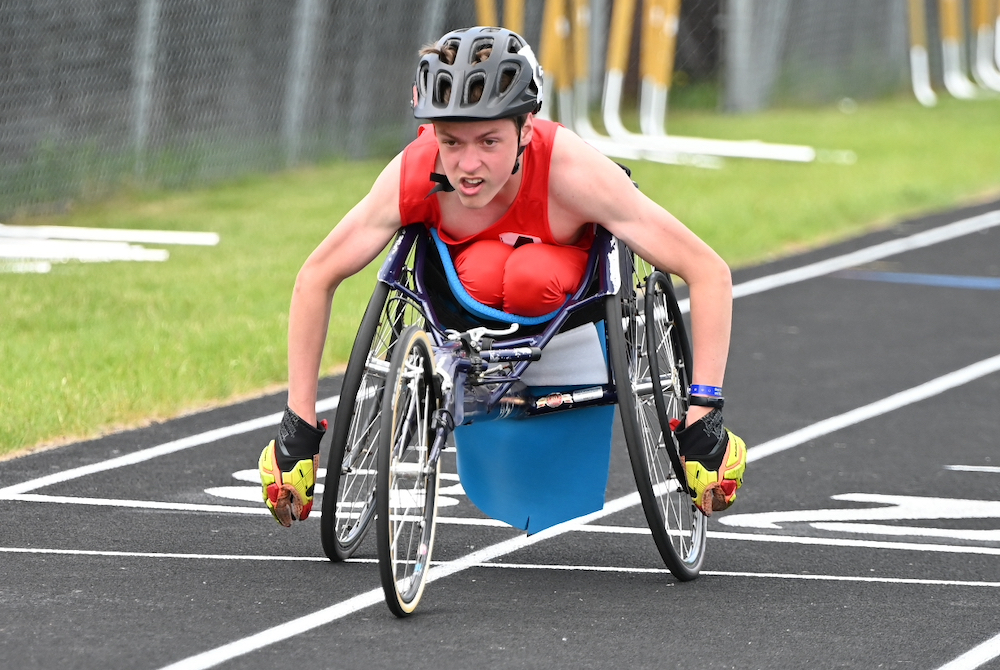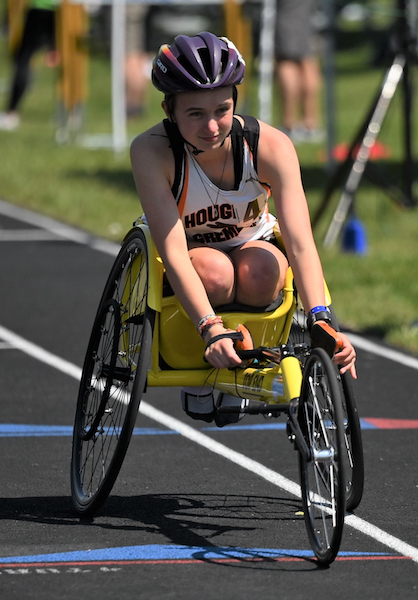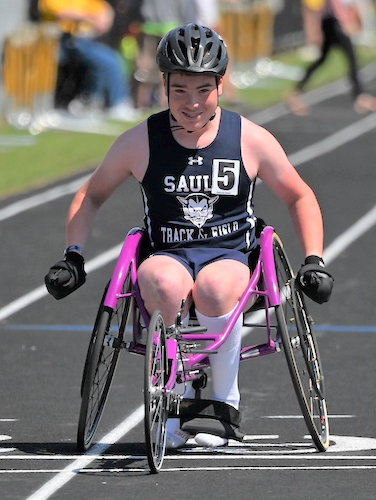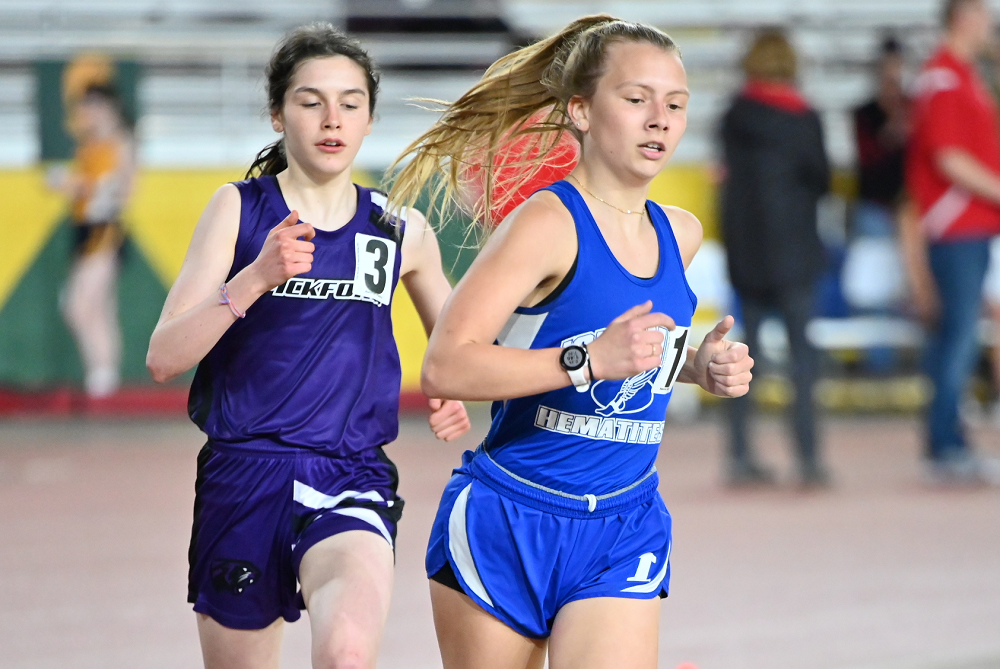
3 Upper Peninsula Athletes Among History-Makers in 1st Finals Adaptive Events
By
John Vrancic
Special for MHSAA.com
June 17, 2022
KINGSFORD — A trio of Upper Peninsula wheelchair athletes were among five statewide who concluded their seasons June 4 competing in first-time adaptive events at MHSAA Finals.
 This spring, the MHSAA Track & Field Regionals and Finals included its first adaptive 100, 200 and 400-meter dashes and shot put.
This spring, the MHSAA Track & Field Regionals and Finals included its first adaptive 100, 200 and 400-meter dashes and shot put.
“Learning the technique and staying motivated is very challenging,” Houghton senior Maria Valet said after the Western Peninsula Athletic Conference meet May 31 at Calumet. “I go to regional competition downstate and in Indiana and Wisconsin. I also do little bit of weight training, but practice mostly on the track. I also work a little bit with Dean Juntunen (a longtime wheelchair racer from Ontonagon), who gives me some pointers. It’s good to have something to work for and see other people do it.”
 Joining Velat at the Upper Peninsula Finals in Kingsford were Marquette freshman Jim Bennett and Sault Ste. Marie freshman Johnny Osborn.
Joining Velat at the Upper Peninsula Finals in Kingsford were Marquette freshman Jim Bennett and Sault Ste. Marie freshman Johnny Osborn.
Velat covered the 100 in 26.56 seconds, 200 (51.15) and 400 (1:35.96) and recorded a 10-foot toss in shot put.
Her effort in the 400 at the Finals was nearly a personal-best.
“My best time in the 100 is 25.7 and I’ve done the 200 in approximately 48 seconds,” she said. “I think the 100 is my hardest event because it’s harder to gain momentum.”
Velat will attend the University of Michigan and major in biology. She will also be on the track team.
Bennett shattered his previous best time in the 200 by more than 2½ seconds was clocked at 24.31 in the 100 and 1:39.74 in the 400.
“It feels real good to race against other people,” he said. “I haven’t had the opportunity to do this before. There are so many opportunities available. Colleges are looking for wheelchair racers.
 “Today was my best time in the 200 (47.52). It feels great to do that. I had my best time in the 100 (23.15) in Marquette. The longer distances are more challenging for me. Right now I’m building up.”
“Today was my best time in the 200 (47.52). It feels great to do that. I had my best time in the 100 (23.15) in Marquette. The longer distances are more challenging for me. Right now I’m building up.”
Osborn threw the shot 13-4 at Kingsford, missing his personal best by just two inches.
“It means a lot to me to get a chance to compete,” he said. “This helps bring out the competitive spirit. I do cross country, which gives me more endurance and definitely helps me for track. I also manage the basketball team at our school.”
Osborn finished the 100 in 33.18, 200 in 1:17.95 and 400 in 2:21.03.
In the Lower Peninsula, Chelsea junior Jacob Nelson competed in the Division 2 100 meters, and Grosse Pointe Woods University Liggett junior Jacob Juip competed in the Division 3 100 and 200.
 John Vrancic has covered high school sports in the Upper Peninsula since joining the Escanaba Daily Press staff in 1985. He is known most prominently across the peninsula for his extensive coverage of cross country and track & field that frequently appears in newspapers from the Wisconsin border to Lake Huron. He received the James Trethewey Award for Distinguished Service in 2015 from the Upper Peninsula Sportswriters and Sportscasters Association.
John Vrancic has covered high school sports in the Upper Peninsula since joining the Escanaba Daily Press staff in 1985. He is known most prominently across the peninsula for his extensive coverage of cross country and track & field that frequently appears in newspapers from the Wisconsin border to Lake Huron. He received the James Trethewey Award for Distinguished Service in 2015 from the Upper Peninsula Sportswriters and Sportscasters Association.
PHOTOS (Top) Marquette's Jim Bennett races during the UP Finals on June 4. (Middle) Houghton's Maria Velat competed in all four adaptive Finals events in UPD1. (Below) Sault Ste. Marie's Johnny Osborn also competed in all four events at Kingsford. (Photos by Cara Kamps/Run Michigan.)

Preview: Super Seniors Set to Celebrate Big Finishes at UP Girls Finals
By
Geoff Kimmerly
MHSAA.com senior editor
June 2, 2023
The baton will be passed literally and figuratively several times during the Upper Peninsula Girls Track & Field Finals on Saturday.
Fans will watch the final competitions for a number of accomplished seniors, particularly Marquette’s Baux Truckey as she attempts to add to an impressive career championship haul.
They’ll also cheer on standouts like West Iron County junior Danica Shamion, Ishpeming junior Lola Korpi and Lake Linden-Hubbell sophomore Emily Jokela as they continue their historic rises.
All three divisions will again be contested at Kingsford High School, with preliminaries leading off the day at 9 a.m. local (Central) time. Tickets cost $11 and are available digitally only via GoFan.
MHSAA.tv will live-stream the meets beginning at 9 a.m. (CDT)/10 a.m. (EDT), viewable with subscription.
Following is a glance at team contenders and individuals to watch in all three divisions:
Division 1
Team forecast: Negaunee and Marquette both have won two of the last four championships, the Miners finishing first last season by 21½ points. They competed at separate Regionals two weeks ago, both winning those meets, and appear to be the favorites again – although Houghton and Sault Ste. Marie, the runners-up at those Regionals, have the potential to challenge at the top. Just as Negaunee got big contributions from freshmen last season, Marquette could do the same this time – although both also will say good-bye to accomplished seniors as well.
Claire Filpus, Houghton senior: Last year’s 1,600 champion also was on a relay winner and finished eighth in the 300 hurdles. She’ll run on two contending relays and the 1,600 again, and her 800 time of 2:37.70 was fourth-fastest among both UPD1 Regionals.
Cassandra Gallagher, Sault Ste. Marie senior: She finished first in the 3,200 and fourth in the 1,600 last season, and she returns after running the fourth-fastest 3,200 (12:50.71) and 1,600 (5:49.04) at UPD1 Regionals.
Aubrey Johnson, Negaunee sophomore: The reigning 800 champion also was a key relay contributor to last year’s team title winner, and she could provide some valuable points elsewhere this time entering with the third-fastest UPD1 Regional time in the 800 (2:37.32) and also with a pole vault (9-0) that tied for second-highest between the two sites.
Eliana Juchemich, Negaunee senior: She finished first in shot put and fourth in discus last season but heads into Saturday with the top UPD1 Regional tosses in both at 35-10¼ and 111-4, respectively.
Erika Malone, Kingsford senior: She won long jump by eight inches last season and was fifth in the 100, and she’s slated to run on two contending relays in addition to her repeat attempt.
Madison Pekrul, Negaunee sophomore: Her Finals debut last season also played a major role in the Miners’ title quest as she won the 100 hurdles and finished second in the 300. She ran the fastest UPD1 Regional time in the 100 hurdles (17.27) two weeks ago and the second-fastest in the 300 (50.74), and she’ll also compete on the favored 1,600 relay.
Faith Spiroff, Ishpeming Westwood sophomore: Last season’s high jump champion and fourth-place finisher in the 200 as just a freshman as well, she’ll enter the weekend after tying for the third-best high jump (5-0) at UPD1 Regionals, the second-best long jump (15-9½), and posting the fifth-best 100 and 200 times.
Baux Truckey, Marquette senior: She’s won the 100 and 200 the last two seasons and may add three more titles after running the fastest 100 (12.88) and 400 (1:04.09) and third-fastest 200 (26.79) at UPD1 Regionals. She’s also run on four relay champions over her career.
Division 2
Team forecast: Bark River-Harris was one of the top stories of last year’s Finals winning its first team championship, and the Broncos won their Regional two weeks ago just ahead of Manistique, while Ishpeming won the other Regional by an even closer margin over West Iron County. When considered together, Bark River-Harris’ depth and Ishpeming’s star power appear to be the main factors in this meet, although the Emeralds could play an interesting role with plenty of contenders.
Mckenzie Hoffmeyer, Bark River-Harris junior: She was a major scorer as BR-H won that first team title last spring, winning long jump, finishing second in the 100 and 200 and running on a first-place relay. Saturday’s schedule sees her on at least one relay but also entering with the top UPD2 Regional long jump (15-5) and third-fastest 100 (13.41) and 200 (27.92).
Lola Korpi, Ishpeming junior: Korpi has won the 800, 1600 and 3,200 the last two seasons. She’ll enter with the fastest UPD2 Regional times in the 800 (2:37.82) and 1,600 (5:25.79) and second-fastest in the 3,200 (12:48.12).
Danielle Lund, Manistique junior: The reigning shot put champion also was second in the discus and ran on the winning 1,600 relay last season, and she could run two relays this time while also entering with the second-farthest shot put (33-1½) and discus (92-8) tosses from UPD2 Regionals.
Lena Pleaugh, Gwinn senior: The reigning 100 hurdles champion also was fourth in long jump and seventh in the 200 last season, and she’ll look to repeat in the 100 hurdles with the second-fastest UPD2 Regional time (17.49) plus contend in the 300 hurdles after running the fastest (52.27) two weeks ago. She also was fourth-fastest in the 100 (13.47) at UPD2 Regionals.
Kadence Potoczak, Pickford senior: She threw the longest discus toss (94-0) and fourth-farthest shot put (30-6) at UPD2 Regionals after winning discus and finishing fourth in shot put at the UPD3 Final last year.
Danica Shamion, West Iron County junior: Shamion also is a six-time individual winner with titles in the 100, 200 and 400 the last two seasons. And she could join the elite four-champion club Saturday as she enters after running the fastest 100 (13.06), 200 (27.11) and 400 (1:00.69) at UPD2 Regionals, plus tying for the top high jump (5-0).
Carley Varoni, Bark River-Harris senior: She won the pole vault by six inches last season and posted the second-highest vault at UPD2 Regionals (8-0) two weeks ago – plus she could run on three relays after running on two a year ago.
Division 3
Team forecast: Ontonagon has won the last two Division 3 championships, last season by 12 points ahead of Stephenson. The Gladiators are loaded in relays and have sprint speed to win again, but Stephenson has similar strengths and qualifiers all over the field events. Newberry and Munising could counter with plenty of scoring in distance events as well.
Kaylen Clark, Newberry junior: The UPD3 cross country runner-up in the fall enters this weekend with the top UPD3 Regional times in the 1,600 (5:47.86) and 3,200 (12:37.24). She finished second in both in UPD2 last season.
Abi Codere, Lake Linden-Hubbell junior: She won the 100 hurdles and was second in pole vault last season, and is looking at possible titles in both with the second-fastest UPD3 Regional time in the 100 hurdles (17.27) and the top pole vault (9-6) by a foot.
Grace Hill, Brimley senior: The reigning shot put champ and discus runner-up threw the top shot (31-5¼) at UPD3 Regionals and the third-farthest discus toss (98-4).
Emily Jokela, Lake Linden-Hubbell sophomore: She made her Finals debut with wins in the 200, 400 and 300 hurdles and a third place in the 100 dash, and she’ll build on that entering this weekend with the fastest UPD3 Regional times in all four – the 100 (13.30), 200 (27.23), 400 (1:01.52) and 300 hurdles (47.22).
Nora Keranen, Dollar Bay sophomore: She won the long jump as a freshman and also finished eighth in the high jump and pole vault, and will return after tying for the top high jump height (4-10) and third-best pole vault (7-6) at UPD3 Regionals.
Jada Kuntze, Stephenson junior: She also tied for the top high jump height (4-10) at UPD3 Regionals and ran the third-fastest 800 (2:36.95) as she looks to add to last season’s championship in the high jump and runner-up finishes in the 800 and 1,600 relay.
PHOTO Ishpeming's Lola Korpi, right, leads the 800 run during the April 17 Superior Dome Invitational, followed closely by Pickford's Talya Schreiber. (Photo by Cara Kamps.)

